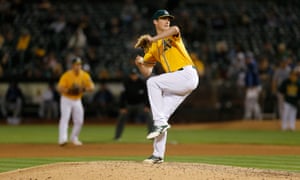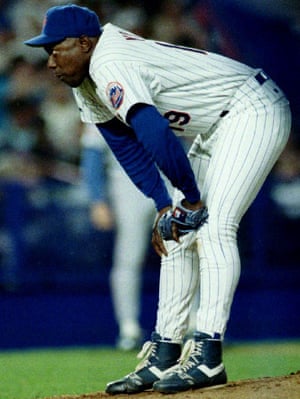Chris Bassitt’s first Major League Baseball pitching start came for the Chicago White Sox in late August 2014. He was 25 years old, just slightly older than the average age for a pitcher’s debut in the league. He had gotten the phone call notifying him of the start only two days earlier, and it had taken him completely by surprise. He spent the next 48 hours in an emotional and logistical cyclone, traveling, fielding congratulatory phone calls from friends and family, and obtaining tickets for those same friends and family, about 70 of whom made it to the game.
“It’s such a whirlwind, that first game,” he said at spring training in Arizona earlier this month. “Everything is going a million miles an hour. Baseball was about one-tenth of what was actually going on.”
Bassitt took the mound for the White Sox in front of almost 25,000 people, or more than 10 times the size of the crowd he had just pitched before in his last minor-league outing, in Pearl, Mississippi. Bassitt’s opponent that day had been the double-A Mississippi Braves. For his major league debut it was the White Sox’s division rival Detroit Tigers, a team that had lost in the American League Championship Series the year before and was now in the thick of the current season’s playoff race, one game out of first place and 13 games ahead of Chicago, who were essentially out of contention.
Six-foot-five, thin, and gangly, Bassitt walks slowly and looks at the ground when he takes the field to pitch, trying to eliminate distractions – in the case of one’s major league pitching debut, it helps not to look even inside the dugout, where a quick glance would be met by a handful of television cameras pointed straight at you, broadcasting your image across the country. As Derek Johnson, the Milwaukee Brewers pitching coach and author of the book The Complete Guide to Pitching, told me, “the younger pitcher has to work on learning how to get quiet in bigger situations. Their mind has a tendency to go all over the place.”
For his big league debut, Bassitt seemed to rise to the occasion. He got the Tigers leadoff batter, the nine-year veteran Rajai Davis, to ground the ball back to him for the first out. He got the team’s all-star second baseman, Ian Kinsler, to fly to center for the second out. But when the Tigers’ No3 hitter came to the plate, the moment became charged in a way it hadn’t been before. “Seeing Miguel Cabrera [the American League’s reigning MVP] step in the box against you instead of some random triple-A guy, it’s, like, OK, we’re here,” Bassitt said. “I’m used to playing video games with him, not actually playing against him.”

Bassitt started Cabrera out with a 94mph fastball down the middle. Cabrera fouled it off. With his second pitch, Bassitt threw another fastball that tailed inside for strike two. Two pitches later, he threw a slow, looping curve ball that fooled Cabrera so badly he didn’t even swing and struck out to end the inning. After a good pitch, Bassitt has a tendency to skip off the mound. After that pitch, he took the skip a step further. “I never run off the field,” he said, “and I ran off the field after that one.”
That would be as good as his debut got. Bassitt gave up two runs in the third inning and three more in the fourth. Before he knew it, he was down 5-0 and on his way to his first big league decision and his first big league defeat. Unfortunately for Bassitt, there would be more losses to come. But those were still another year away. He started four more games for the White Sox in 2014, including one in which he earned his first career victory, a 2-0 win over the Tigers (Cabrera went 1-4 against him). He pitched well enough in those games that if everything went according to plan, he had a very good shot at beginning the 2015 season for the White Sox as one of the starting pitchers in their five-man rotation. But everything did not go according to plan.
Major League Baseball bills its six-month season as an escalating competition led by a cast of all-star players with its climactic episode occurring in October’s World Series. Yet arguably the most competitive feature of the game takes place on a stage far less grand than its fall championship, in nearly every regular-season game from opening day onwards. The protagonists of these competitions are not the game’s most celebrated players but rather those who straddle the line between the major and the minor leagues. For them, what’s on the line isn’t just one result of a 162-game schedule – success isn’t measured in terms found in the MLB standings. It’s measured in how long the player, once given the opportunity in the majors, is able to remain in the league.
***
In 1991, almost 25 years before Chris Bassitt threw his first major league pitch, 25-year-old New York Mets pitcher Anthony Young made his first major league appearance. Baseball players cite many factors that keep someone from making it in the majors. Injuries and an inability to adapt to the pressures that come with playing there are often mentioned. So is bad luck, and no one had more bad luck than Anthony Young.
Young had been drafted in 1987, in the 38th round, from the University of Houston, which he had attended on a full scholarship – for football. His baseball talent was a raw one. “When I was playing little league ball in Houston, I always threw the ball hard, but I never knew where it was going,” Young said a few weeks ago by phone from Houston, where he currently runs a baseball facility and coaches youth teams. “High school, same way. Got to college, same way. When I was starting a game in college, they would have people already in the bullpen warming up because they never knew what I was going to do.”
In Little Falls, New York, at his first minor league camp the summer he was drafted, the Mets team scout told Young to pitch exactly how he had been pitching, to try to throw the ball through the wall and not to worry, that the Mets pitching coach would take care of the rest. It’s what happened. Two years later, Young was an all-star in single-A minor-league baseball in Columbia, South Carolina. The following year, he was an all-star in double-A in Jackson, Mississippi. In addition to his fastball, Young had now added a curveball, change-up, and slider, the latter of which had become his “out pitch,” the one he threw when he needed to get an out.
Though a starter in the minors, Young made his debut with the Mets in relief, against the Chicago Cubs, with the bases loaded and one out in the seventh inning of a game the Mets trailed 6-1. Mets fans at Shea Stadium that night might have already given up on the game. Cubs fans might have stopped paying attention. But when the bullpen gate opened, Young said, describing how he felt, “nervous wasn’t the word. I couldn’t hear a sound. It was like running through a tunnel.”
With his second pitch, Young got the Cubs’ two-time all-star shortstop Shawon Dunston to ground into a double-play to get the Mets out of the inning. Four days later, Young threw two hitless innings in relief, again against the Cubs. The day after that, he was back in the minors. The Mets never told him why. “The only thing you’re thinking about,” Young said about being sent down from the majors, “is getting back up there.”

The life of a minor leaguer is not a glamorous one. Players often have to wake up at 4am to catch a cross-country flight for a night game the same day, or take an eight-hour bus ride across three states to make it in time for a game that’s only slightly better attended than a competitive little league contest – and then get right back on the bus when it’s over. Last year, one team, the double-A Biloxi Shuckers, were on the road for 55 days straight because their home stadium wasn’t finished in time for the start of the season. Peanut butter and jelly sandwiches are a favorite meal – not only is it the only food around in the clubhouse; it’s often all the players can afford. These conditions become far worse once a player has had a taste of the big leagues, where the current minimum salary is $507,500. Even the most experienced and highest paid player in the minors can exceed his pay for an entire year in one month in the majors.
When players get sent back down to the minors, it’s not unusual for them to show frustration. Last year, one player on the triple-A team the Colorado Springs Sky Sox used his helmet to destroy a sink in the dugout after he struck out, and the game had to be stopped because water was gushing up the first-base line. His team-mates held out buckets to catch the cascade.
In 1992, Young made the Mets Opening Day roster as the fourth pitcher in their starting rotation. He won his first two decisions, and then he lost one. Then he lost another, and another, and another. It wasn’t so much that Young was pitching poorly but that he was getting little help from his team. In four games that he pitched over the course of June, all losses, the Mets scored a total of four runs. By 4 July, Young had lost nine straight decisions, and the Mets dropped him from the rotation.
There are only two places a pitcher can go after he loses his starting job: the bullpen or the minors. As it happened, at the same time Young lost his job, the Mets closer, future hall of famer John Franco, lost his, to an elbow injury. To replace Franco, the Mets decided to alternate three different pitchers in his place. Young was one of them. He converted his first two save opportunities, and the Mets began to use him exclusively. Young converted his next 10 save opportunities as well. He couldn’t believe how easy it was compared to having to start games and pitch six or seven innings with no run support. Over the course of 20 appearances in July and August, Young threw 23-2/3 consecutive scoreless innings.
“One’s temperament for being closer isn’t tested until you have had your rear end kicked and then have to come back the next night,” Mel Stottlemyre, the Mets pitching coach at the time, told the press during Young’s streak to appease the reporters’ excitement. On 3 September, Young got tested. He blew his first save of the season, to the Cincinnati Reds, when he gave up two runs in the ninth to lose 4-3. It was his 10th loss of the season. Two nights later, he blew another save and suffered his 11th loss. The following week he blew two more.
Young reassessed the closer role. After he blew his first save, he told me, “that’s not a great feeling. It was good when the good was going. But blowing a save, giving up the lead, and then getting a loss the next time, I was, like, ‘Oh, this shit ain’t that easy. I see why Franco gets paid the money he gets paid.’”
Young ended the season with a win-loss record of 2-14, a 4.17 earned-run average (a little higher than the league ERA average), and an active 14-game losing streak that he would carry with him into the 1993 season. And then the bottom completely fell out.
***
Two weeks before Christmas 2014, as Chris Bassitt prepared for his first full spring training in the majors, the White Sox traded him to the Oakland A’s, as part of a six-man deal for the A’s all-star pitcher Jeff Samardzija. It didn’t change Bassitt’s major-league status – he would still be competing for a spot as a starting pitcher, but it changed the circumstances under which he’d be doing it. A charismatic presence in his past clubhouses, used to trash-talking over the ping pong table, Bassitt was now the new guy in an unfamiliar environment. He hardly knew a single person on his team. To deal with it, he was determined not just to impress his new coaching staff enough to make the rotation. He meant to blow them away.
His first start that spring went well enough, but in his second he gave up five runs in three innings. It only got worse from there. “I tried to do way more than what I was really capable of, and it just fell apart on me,” he said. With every successive poor outing, the pressure snowballed. Each time he took the mound, he’d think, “I’ll perform even better this time to show them that the last one was a fluke. Then that one sucked.” Bassitt still ended up pitching Opening Day that year – but for the Nashville Sounds, Oakland’s triple-A affiliate.

The A’s called Bassitt back up as a reliever at the end of April, but those outings didn’t go any better than the ones in the spring had. In five appearances, he pitched 10 innings and walked nine batters. Two weeks later, he was back in Nashville. “I fell into the same trap I did in spring training,” he said. “I tried to throw too hard, and I got out of whack.”
One way to see Bassitt’s trade to the A’s was that he’d been hand-picked by Oakland’s celebrated general manager, Billy Beane (otherwise known as Brad Pitt in the film Moneyball, based on Michael Lewis’s book of the same name), who had an uncanny talent for finding hidden treasures among the bargain-basement racks. Bassitt fit the mold.
“I [have always been] underhyped, underrecruited,” he said. “Everything’s always been, ‘I don’t know if I am good enough. I’ve got to prove it to myself because no one else has given me the attention that it’s like I am.’”
Bassitt grew up in Curtice, Ohio, a suburb of Toledo, where he was a three-sport varsity letterman. Basketball, in which he was the team’s point guard, was his favorite sport; football, in which he was the team’s quarterback, was his worst; and baseball his best. Already in high school, he had all the pitches he’d bring with him to face Cabrera eight years later – fastball, cutter, changeup, curveball, and slider. The baseball coach at University of Akron had taken notice of him, though not enough to offer a scholarship. He invited Bassitt to try out. Bassitt made the team as a walk-on his freshman year, became the team’s closer, and pitched his way to a scholarship, after all.
The White Sox drafted him in 2011, in the 16th round, five hours and more than 500 picks after the draft began. He first pitched in single-A ball in the minors that same year, for the Winston-Salem Dash. At 22, Bassitt wasn’t yet completely matured physically, but most of his team-mates were. He was a sapling among fully-grown redwoods. It took him two years before he began to shine, now as a starting pitcher, at double-A ball in Birmingham, which is where he was when he got his first call to the majors.
Bassitt has a high leg kick and broad, sweeping arm action when he pitches – in other words, several moving parts. “His delivery has a lot of character,” said Curt Young (no relation to Anthony), the A’s pitching coach. “The energy that he has in it is very deceptive and different looking to hitters, so that makes him tough to hit.” But that energy can also complicate matters. The most difficult aspect of pitching for Bassitt is the physical part, keeping his body in line, his pitching mechanics in order.
The A’s called Bassitt back to the majors as a starter at the end of June, after he’d made adjustments to his delivery, simplifying his hand motions. The adjustments seemed to work. Incredibly, in his first seven starts for the A’s, he gave up only 11 runs. What he had struggled with before – control, getting ahead of hitters in the count, finishing them off – looked to be a problem of the past. But Bassitt now had a new problem to deal with: losing. The A’s were the worst team in the American League. When Bassitt was in the game during those first seven starts, the A’s scored a total of 10 runs, and five of them came in one game. Bassitt lost his first four starts, won one, and then lost four more.
“It was not fun by any means,” Bassitt said of the losses. “I was almost about to fall in the trap that I did in spring training. [Try to] do more. We’re not scoring many runs, so hold the other team to zero.”
Bassitt ended the season with a 3.56 ERA (the league average was 4.01) and a record of 1-8. No player in all of baseball with nine or more decisions had a worse win-loss percentage. Depending on how you viewed him, Bassitt had finished the year as either the best worst pitcher in the majors or the worst best one. But he was unequivocally a major league pitcher. In 2016, the question would be, could he remain one.
***

The New York Mets’ 1992 season was so bad that two journalists wrote a book about it called The Worst Team Money Could Buy. When Young started the 1993 season, he couldn’t imagine that any year could go worse. But this one did, and not only for the Mets. Young lost in his first appearance of the season, against the Houston Astros. Dating back to the end of the prior year, it was his 15th consecutive loss. He lost his 16th when the winning run was scored on a team-mate’s error. He lost another, to the San Diego Padres, after he gave up a single to the first batter of the game, retired the next 23 hitters he faced, and then in the eighth inning gave up a single and a two-run opposite-field home run, by the Padres’ backup catcher. The Mets had one hit that day.
The Mets tried Young as a starter, as a closer, as a setup man for the closer, and in middle relief. Nothing seemed to work – not for the Mets and not for Young. The flip-flopping between starting and the bullpen got under his skin. It’s something most every major-league pitcher hates, because the mental preparation for the two differs so greatly. “I never felt comfortable,” Young said. The only thing the Mets didn’t do is send him down to the minors. But the unspoken threat of it never went away.
As Young approached the 82-year-old record for most consecutive losses in the major leagues – 23, set by Boston’s Cliff Curtis in 1910-11 – he became a regular punchline in Jay Leno’s Tonight Show monologues. In New York, things weren’t any better. “After one loss, [Mets pitcher] Pete Schourek and I went to [the restaurant] Benihana and had to sit with other people,” Young said. “The conversation got to, ‘Did the Mets win today?’ I say, ‘No.’ One guy says, ‘Who pitched?’ Somebody says, ‘Anthony Young.’ The guy says, ‘Yeah, we should have known we were going to lose if he was pitching.’ And Pete says, ‘Hey, I want you to meet Anthony Young.’ That guy never looked back up. He ate his food and got the hell out of there.”
Young broke Curtis’s record on 27 June against the St Louis Cardinals. But the losses kept coming: 3-1 to the San Francisco Giants, 5-4 to the Los Angeles Dodgers. On 28 July, 27 losses and more than 15 months since he’d last won a game, Young entered a tied game against the Florida Marlins in the ninth inning. He got into a bases-loaded, no-outs jam after a throwing error by catcher Todd Hundley and a mental error by third baseman Bobby Bonilla. He gave up one run, unearned after the Hundley error, and the Mets went into the bottom of the ninth trailing 4-3. “What people don’t know,” Young said, “I was about to lose the 28th one.” In the bottom half of the inning, the Mets first baseman Eddie Murray hit a double down the line that scored the winning run and ended Young’s streak.
Three weeks later, the Mets finally did send Young down to the minors – “to get it through to him it’s not all about bad luck,” manager Dallas Green said at the time. Young took it badly and asked to be traded. But he was back in the majors, and with the Mets, in two weeks. He ended the season 1-16, with a 3.77 ERA.
Young pitched three more years in the majors – only one of them completely free of the minor leagues – before injuries ended his career. As notorious a record as his losing streak is, he managed to pull off an incredible feat in the midst of it – to be good enough that he could lose so many games and remain in the major leagues to lose so many more.
“They say the easy thing is making it to the big leagues,” Young told me. “The hardest thing is staying there.”
***
The Oakland A’s spend spring training in Mesa, Arizona. One way to get to the team’s complex there is to drive down state highway 202, past the eye-catching, age-old landscape of the Phoenix Mountain Range in the distance with a foreground full of nothing but creosote bushes and lunar-like rock formations that have stood for centuries, long before there was ever a sport called baseball, or a state called Arizona, or even a country called America. It reminds you that, as one reporter in the press box said to me, “we’re all ants, trying to be the best ants we can be.”
The ants that make up the 2016 Oakland A’s are a motley collection of Beane’s shopping sprees over recent years. Not many pundits have any real clue how the team will perform this season, but very few have slotted in the A’s for a post-season playoff spot, which might make wins hard to come by for its pitching staff.
But Chris Bassitt’s not thinking about that right now. He spent the off-season tinkering again with his delivery, after it became evident near the end of last season that he’d begun tipping his pitches. (Three of his last four starts in 2015 were his worst of the year.) Both Curt Young, the pitching coach, and Bob Melvin, the manager, have been pleased with what they’ve seen from him this spring (through his first four starts, he had the lowest ERA among the A’s projected starters), and he appears on track to secure the third or fourth spot in the A’s rotation. But, as Bassitt put it in the harsh terms of baseball reality, “Hitters are going to tell me if the wind-up is good or not.”
“Everybody’s got their own little time and transition,” said Steve Scarsone, the manager of the Nashville Sounds, where Bassitt played triple-A ball last season. “Which makes it great, because now everybody’s got an individual story.” However Bassitt’s story turns out, it might be helpful to remember that if it resembles Anthony Young’s in any way, that might not be so bad. Sometimes just staying in the major leagues is a victory.



